Secure unlicensed U.S. and Canadian market access with F2 Labs’ FCC Part 15 compliance services. We conduct radiated and conducted emissions testing, product documentation, and assistance to achieve FCC certification for wireless and electronic devices.
FCC Part 15 Compliance Testing and Certification
The FCC has mandatory requirements before a product can be used, sold, or even marketed in some cases. Depending on the type of equipment that the product is, manufacturers are required to meet the FCC requirements for Certification and Supplier’s Declaration of Conformity (SDoC), formerly Verification or Declaration of Conformity (DoC). The most common FCC requirements are FCC Part 15 Subpart A, FCC Part 15 Subpart B, FCC Part 15 Subpart C, and FCC Part 18.
A lot of manufacturers do not know or believe their products have to be tested for FCC compliance. This is due to a lack of information or research and the misconception that there is only a requirement if the product uses RF intentionally or is a wireless product, but that is not the case. FCC Part 15 Subpart B is for unintentional radiators that use IC chips, oscillators, clocks, or one of any other numerous active electronic components.
FCC Suppliers Declaration of Conformity (FCC SDoC), formerly Verification, is a process that requires the manufacturer to ensure that their product complies with the requirements of the appropriate FCC rules and regulations. FCC Part 15 Subpart B lists the emissions limits and requirements. Testing to the appropriate test methods is typically the only way to prove the requirements are met. F2 Labs is an accredited laboratory with the equipment, experience, and expertise to help ensure your product is compliant with the appropriate regulations. For testing to FCC Part 15 Subpart B, there is no requirement for the test data or information to be submitted to the Commission for approval unless specifically requested. Products must be labeled appropriately to show that they are in compliance with the FCC rules for Supplier’s Declaration of Conformity (FCC SDoC). These labeling requirements are also given in FCC Part 15.
Per the FCC KDB 996369 D01 Module Equip Auth Guide V02:
A hosted product itself is required to comply with all other applicable FCC equipment authorization regulations, requirements, and equipment functions that are not associated with the transmitter module portion. For example. Compliance must be demonstrated: to regulations for other transmitter components within a host product; to requirements for unintentional radiators (Part 15 Subpart B), such as digital devices, computer peripherals, radio receivers, etc.; and to additional authorization requirements for the no-transmitter functions on the transmitter module (i.e., Supplier’s Declaration of Conformity, formerly Verification or Declaration of Conformity) as appropriate (e.g., Bluetooth and Wi-Fi transmitter modules may also contact digital logic functions).
To ensure compliance for all non-transmitter functions, a host product manufacturer is responsible for ensuring compliance with the module(s) installed and fully operational. For example, if a host product was previously authorized as an unintentional radiator under the Supplier’s Declaration of Conformity, formerly Declaration of Conformity, procedure without containing a certified transmitter module, then a module is added, the host manufacturer is responsible for ensuring that the host continues to be compliance with the FCC Part 15 subpart B unintentional radiator requirements after the module is installed and operational. Because this may depend on the details of how the module is integrated within the host, the module grantee (the party responsible for the module grant) shall provide guidance to the host manufacturer for ensuring compliance with the Part 15 Subpart B requirements.

FCC Certification is covered under Part 15 Subpart C for intentional radiators. The most common types of intentional radiators are Wi-Fi or Bluetooth devices, remote control devices, intermittent transmitters such as garage door openers, and alarm transmitters. Intentional radiators covered under FCC Part 15 Subpart C must have their product tested and certified by an accredited laboratory like F2 Labs, and then submitted for approval by the Commission or an approved Telecommunications Certification Body (TCB). Once the product is approved, a Grant is issued and the manufacturer can start to market and sell their product with the approved labeling.
The FCC Part 15 Subpart C rules for marketing, sales, and use of radio transmitters are fairly clear with regards to the limits and requirements of each test required, but FCC Part 15 Subpart C does not list the procedures for performing the tests. There are other technical standards used for the procedures and test methods. These standards are listed throughout FCC Part 15 rules like FCC Part 15.31. There are also other requirements not listed directly in the FCC Part 15 Subpart C rules. They are known as KDB’s that the Commission releases with additional requirements and sometimes even changes. These can be found on the FCC website under the Knowledge Database (KDB) section but can be very difficult to navigate and understand if you are not sure what you are looking for. F2 Labs is very familiar with this process and can easily assist you through this process. Contact us for consultation, evaluation, and FCC testing Part 15 certification, Part 18 compliance testing, FCC SDoC testing, and more.
What is FCC Part 15 Compliance?
FCC Part 15 Compliance refers to regulations set by the Federal Communications Commission (FCC) to control radio frequency (RF) emissions from electronic devices. These rules ensure electronic products:
- Do not interfere with other devices
- Maintain compatibility with communications services
Who Needs FCC Part 15 Certification?
Manufacturers marketing electronic devices in the U.S. must meet FCC Part 15 requirements. This includes:
Devices That Require FCC Part 15 Certification:
- Intentional Radiators: Wi-Fi devices, Bluetooth devices, wireless transmitters
- Unintentional Radiators: Electronic devices with IC chips, oscillators, or other components emitting RF incidentally
What is the Difference Between Intentional and Unintentional Radiators?
- Intentional Radiators: Devices designed to emit RF signals, such as wireless transmitters or Bluetooth devices.
- Unintentional Radiators: Devices that incidentally emit RF due to their electronic components, like digital devices or IC chip-based products.
What is the Supplier’s Declaration of Conformity (SDoC)?
The Supplier’s Declaration of Conformity (SDoC) allows manufacturers to self-declare compliance with FCC regulations for certain products. Key points include:
- No need to submit documentation to the FCC unless requested
- The manufacturer must maintain test reports and necessary documentation for inspection
What are the Labeling Requirements for FCC Compliance?
Products compliant with FCC Part 15 must include proper labeling. These labels:
- Indicate compliance with FCC rules
- Include the manufacturer’s identification and a compliance statement
- Follow specific guidelines outlined in FCC Part 15
What is FCC Part 15 Subpart C?
FCC Part 15 Subpart C governs intentional radiators, such as wireless transmitters. Products under this category:
- Must be tested and certified by an accredited laboratory
- Require approval from the FCC or a Telecommunications Certification Body (TCB)
How Can F2 Labs Assist with FCC Part 15 Compliance?
F2 Labs is an accredited laboratory offering comprehensive services for FCC Part 15 compliance, including:
- Part 15 Subpart B: Testing for unintentional radiators
- Part 15 Subpart C: Testing and certification for intentional radiators
F2 Labs provides end-to-end support, including testing, documentation, and submission for FCC approval.
Are There Additional FCC Compliance Procedures Beyond the Rules?
Yes, the FCC regularly updates requirements through Knowledge Database (KDB) publications. These may include:
- Additional compliance guidelines
- Rule changes not directly listed in Part 15
Navigating these updates can be challenging, but F2 Labs is well-versed in these procedures and offers expert guidance.
